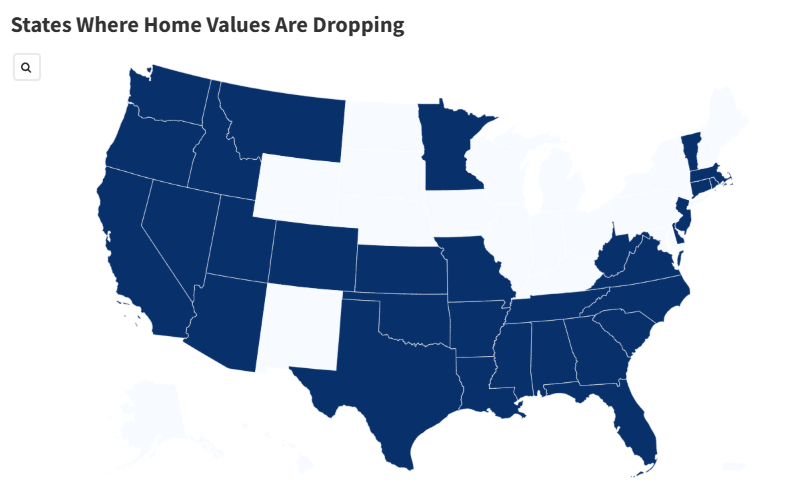Nationwide Housing Market Downturn: Home Values Decline in Multiple States
The U.S. housing market is experiencing a significant downturn, with home values dropping in half of the country. According to Zillow, 27 out of the 50 states reported decreases in monthly home values this year. States like Florida, California, Colorado, Washington, D.C., and Washington state saw the steepest declines between March and April, hinting at a potentially larger shift in the market.
What’s Behind the Decline?
Alex Beene, a financial literacy instructor at the University of Tennessee at Martin, emphasized that the downturn is attributed to a "bad combination of factors." Economic uncertainties are discouraging potential buyers, leading to a ripple effect in the housing market.
Key Points:
- Rising Inventory: Though low inventory had driven prices up in previous years, new listings are now emerging, contributing to decreasing home values.
- High Mortgage Rates: Historically elevated mortgage rates have priced many buyers out of the market.
The Impact of Inventory Changes
Why It Matters:
As inventory levels rise across the U.S., home values are adjusting downwards. While many regions have seen prices increase in recent years, the current shifts signify a broader transformation in the housing landscape.
- States Experiencing Drops:
- Florida: Worst drop at 0.55%
- Other States:
- Colorado: -0.47%
- Washington D.C.: -0.44%
- California: -0.42%
- Arizona, Louisiana, West Virginia, Texas, Georgia: -0.37%
Nick Gerli, founder of the real estate app Reventure, notes, "The broadening of this housing decline suggests there’s a shift occurring in the U.S. Housing Market right now."
Monthly Trends:
While California saw a 1.3% increase in home values over the last year, it experienced a 0.42% decrease in just the past month. This illustrates a critical moment for real estate analysts and potential buyers to assess their strategies moving forward.
Expert Insights
-
Kevin Thompson, CEO of 9i Capital Group, pointed out that housing prices surged after the pandemic, but the economic shift has started to level the playing field.
- According to Hannah Jones, a senior economic research analyst at Realtor.com, this summer is likely to show typical seasonal trends, with potential increases in home sales and prices. However, elevated costs may keep overall activity subdued.
Notable Changes in Buyer Behavior:
- Builders are focusing on smaller, more affordable homes and introducing various incentives to attract buyers.
- The ongoing high mortgage rates mean that affordability remains top-of-mind for many buyers, compelling them to seek better value in their home purchases.
What Lies Ahead?
Most analysts perceive high-interest rates as a primary obstacle in the housing market, but Thompson argues that the prices themselves play a pivotal role in market improvement.
Future Predictions:
- Ongoing Price Corrections: Expect continuation in price declines while mortgage rates persist at high levels.
- Market Dynamics: Some regions may see price drops, while others may continue to appreciate.
Most importantly, buyers will gain more choices and experience less competition in the market.
Seller Strategies in Changing Times
For sellers, the landscape has shifted dramatically. Gone are the days of overshooting market prices:
- Importance of Accurate Pricing: Sellers must price their homes realistically as overpricing can lead to stagnant listings.
Michael Ryan, finance expert, compares the situation to "coming back down to earth from a sugar high," indicating that normal market conditions are returning.
Conclusion
The current downturn in the housing market, reflected by falling home values in numerous states, signals a complex interplay of factors — from rising inventory to high mortgage rates. As we look ahead, the importance of realistic pricing and adapting to changing buyer preferences will define the real estate landscape.
Stay Informed!
For potential buyers, investors, and real estate enthusiasts, keeping an eye on these trends will be crucial for making informed housing decisions. As the market evolves, so too will the opportunities.


